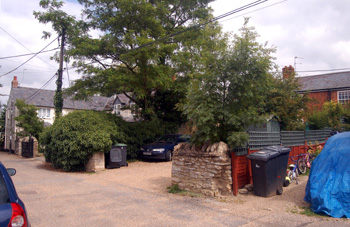
Site of the Parish Workhouse and Red Lion, July 2008
In the Parish Archive [ref: P33] are three deeds. In 1655 Robert Bedford of Harrold, weaver, devised a cottage in his will to his eldest son Thomas [ref: P33/16/1]. A year later he was still alive as he assigned his shop in Harrold to his son Robert junior [ref: P33/16/2]. In 1699 Robert Bedford conveyed half of a cottage in Harrold (this may be Robert senior's shop) to the Churchwardens and Overseers of Harrold for £6 - the implication being, although it is nowhere stated, that this was to serve as a workhouse.
When the word workhouse is used people normally think of the large, grim 19th century institutions housing hundreds of people in ways not dissimilar to a prison. Such institutions were created by the Poor Amendment Act of 1834. Before this, individual parishes had their own workhouses, these were, no doubt, also grim, but were usually not large. A short article in the Bedfordshire Times of 20th January 1928 throws light on Harrold's parish workhouse.
"An interesting document has been handed to Mr.F.G.Crouch by a Felmersham resident relating to that old-time institution, the parish workhouse. The document is an agreement made between Mr.Jonathan Quince of Dunstable and the churchwardens and overseers of the parish of Harrold. It is written on parchment in a good bold handwriting, bears the date of 1751, and adds, with a good deal of elaboration, and redundant phraseology that "this is the 24th year of the reign of our Sovereign Lord King George II".
"It appears that in those days Thomas Surridge and Richard Ashton were the Churchwardens, and Francis Pratt and John Allen were the overseers of the poor. The most onerous duties, apparently, fell on Jonathan Quince, as keeper of the poorhouse, for whilst the overseers were responsible for "bedding and bedclothes, saucepans and kettles for boiling and brewing etc." Jonathan had to be a man of many parts. Among the many duties assigned to him were that he had to "keep and maintain and give wholesome food and drink to the inmates, provide medicine and in the case of broken limbs, surgical aid, teach the children to read and write and cause them all to attend Divine worship on the Sabbath, and be responsible for their good conduct and behaviour at all times". For such duties Jonathan Quince received the sum of £53 per annum "in good and lawful money".
"At the end of the agreement several well-known local names with their seals are appended as parties to or witnesses of the transaction. They include Robert Whitworth, Uriah Clayson, John Clayson, Francis Pratt, John Allen. Without a doubt there are descendents of these families living today in the district. The stamp duty it may be noted is 1/6d.
"From information gained from several of the oldest inhabitants, it is evident that the old workhouse was situated at the top end of Brook Lane, formerly known as "Old Tom King's Yard" and now occupied by Clarke's Boot Tree Factory". If so the former parish workhouse was immediately south of the modern 54 and 56 Brook Lane
If the 17th century property sold by Robert Bedford was the first parish workhouse it was not still in use just over half a century later. In 1768 Thomas Jones of Cople, husbandman and Margaret, his wife, sold a cottage, yard and garden in Harrold to Judith Mee of Harrold, widow for £15. This was described as being in Water Lane and "lately used as a house for the Poor and called the Workhouse, now divided into 2 tenements occupied by John Amis and John Felpts", it abutted west on ground of William Felpts and east on a house of Edward Abraham [ref: GA1041-1042]. Three years later this property was leased out and was then known as the Red Lion [ref: GA1043].
The final record of the parish workhouse at Bedfordshire Archives is an inventory taken in 1794 [ref: P33/12/1] which is as follows: "Caldron & Lid, Pail, Tin Kettle & Lid, 13 Dishes & Spoons, 2 Barrels, 1 Drink Stand, 17 Trenchers, a Frying Pan, 2 Earthen Pots, 3 Brass Kettles, 3 Tables, 1 Doughtrough, 5 Stools, 2 Long Forms, 9 Chairs, 1 Dozen of Knives & Forks, 3 Pair of Fire tongues, 2 Paid of Fire Shovels, 2 Pair of Bellows, 3 Drinkingtins, a Tin Saucepan, a Warmingpan, a Brush, 1 Feather Bed, 6 Flock Beds, 9 Bedsteads, 3 New Blankets, 11 Do., 8 Pair of Sheets, 6 Bedmats, 6 Boxes and coffers, 2 Bedsteads with Curtains, 2 Tubs, 2 Candlesticks, 1 Iron and pads". The former workhouse, as we have seen, had become the Red Lion by 1771 and so this inventory must refer to a different poorhouse unless only part of the poorhouse in Brook Lane became a public house - the records are not full enough to allow further speculation.